The Cable machine is more than just a piece of gym equipment—it’s your one-stop shop for targeting multiple muscle groups.
The Cable machine workouts are versatile and effective ways to improve muscle mass and stability.
They consist of a steel frame that houses a series of pulleys, cables, and weight stacks—different types of handles or attachments to train the muscles from all angles.
The machine usually has adjustable settings, so you can set the height of the pulley and the amount of weight resistance. This makes it a great tool for strength training, functional fitness, and rehabilitation exercises.
Now, let’s discuss some of the best cable machine exercises (based on science and experience) that you can do at the gym.

- 20 Best Cable Machine Exercises To Build Mass & Strength
- 1. Lat Pulldown
- 2. Seated Cable Row
- 3. Straight Arm Lat Pulldown
- 4. Cable Chest Press
- 5. Cable Crossover
- 6. Incline Cable Bench Press
- 7. Cable Pullover
- 8. Cable Overhead Press
- 9. Cable Lateral Raise
- 10. Cable Front Raise
- 11. Cable Upright
- 12. Face Pull
- 13. Reverse Cable Crossover
- 14. Cable Shrug
- 15. Cable Squat
- 16. Cable Stiff-Leg Deadlift
- 17. Cable Pull-Through
- 18. Tricep Pushdown
- 19. Cable Bicep Curl
- 20. Pallof Press
- Cables Machine Workout Routines
- 1. Select Your Goals
- 2. Do Weekly Set
- 3. Upper Body Cable Only Workout Plan
- 4. Lower Body Cable Workout Plan
- 5. 4-Day Full-Body Cable Workout Routine
- References
20 Best Cable Machine Exercises To Build Mass & Strength
Here are the 20 best cable exercises for building mass and strength.
1. Lat Pulldown
Lat pulldowns are a good place to start if you want to add a simple yet effective cable machine exercise to your workout routine. They are easy to learn and very effective at building back strength.
It is a great cable exercise that is widely used by fitness trainers to build bigger lats. This isolating exercise specifically focuses on the back muscles without tiring out the biceps or triceps.
You can perform the different variations of the lat pulldown to keep your workout fresh and challenging.
- Wide-grip lat pulldown
- Close-grip lat pulldown
- Reverse-grip (supination) lat pulldown
- Neutral-grip lat pulldown
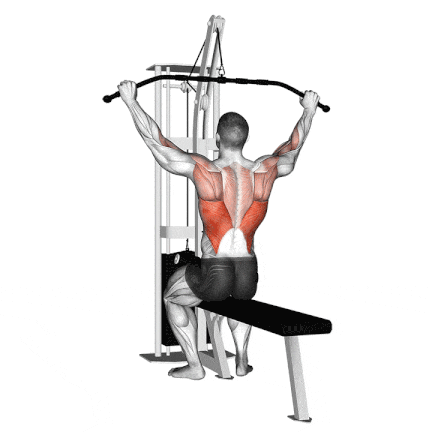
How To Do
- Take an overhand grip, hands slightly wider than shoulder-width apart, and sit on the machine seat.
- Lock your knees under the support pads.
- Keep your upper back straight, pull the bar down and bring it up to the chest.
- As you pull down, squeeze your shoulder blades together and feel your back muscles contracting.
- Perform this movement with your upper back and use your arms merely as a lever between the bar and lats.
- Now, release the bar with controlled motion and stretch your legs as much as possible.
2. Seated Cable Row
The cable row is an effective exercise for building back muscles and increasing overall upper-body strength. It is a compound exercise that works for multiple muscle groups.
Seated Cable Rows are an excellent cable exercise for building middle back muscles, and they also work on the lower back.
This back exercise is done on a cable rowing machine with separate handles, a grip position change, and muscle worked.
- A pronated (overhand) grip targets the upper and middle trapezius.
- A neutral (thumbs up) grip hits the middle and lower trapezius.
- The supinated (underhand) grip switches the focus to the latissimus dorsi.
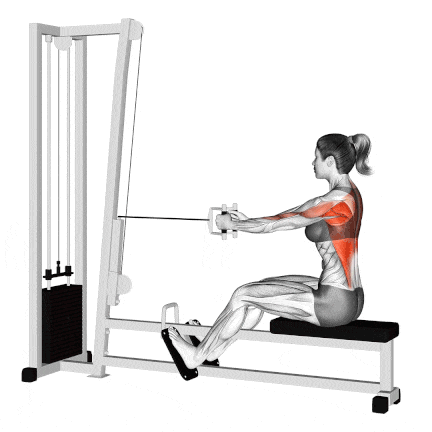
How To Do
- Sit on a seated cable pulley rowing machine with legs slightly bent and feet supported against the crossbar.
- Take hold of the handles with your arms extended and back stretched.
- Pull the handles so that they come as close to the abdomen as possible.
- Pause briefly when the handles are close to the abs and squeeze your upper back muscles.
- Slowly return the handle to the starting position.
Know More: 20 Best Cable Machine Back Exercises For Wider And Strong Back
3. Straight Arm Lat Pulldown
The straight arm lat pulldown is one of the best exercises for strengthening your lats (back). This isolation exercise can also help improve your posture and build a bigger back.
The exercise will primarily target the lats, but you will also notice a fair number of biceps activations. This is a great cable exercise that can really help you widen your upper back.
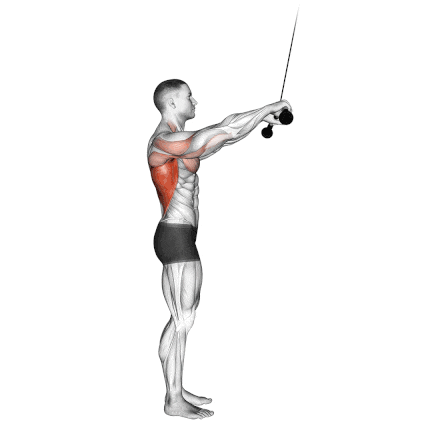
How To Do
- Take an overhand grip wider than shoulder-width on a lat bar attached to the pulley on the lat pulldown bar.
- Position yourself with your feet flat on the floor, chest up, and low-back arch exaggerated.
- Keep your elbows slightly flexed and your body still. Don’t allow the head to jut forward as you pull.
- Pull your shoulder blades together as you squeeze your back to initiate the movement, pulling the bar down smoothly to your midsection.
- Hold the contraction for a moment, then slowly return the bar to its starting position.
4. Cable Chest Press
The standing cable chest press is a variation of the traditional chest press that is performed using a cable machine. It is a compound exercise that targets the chest, triceps brachii, and anterior deltoids.
Cable chest presses are an effective way to strengthen your chest muscles. They have constant tension throughout the movement and a full range of motion.
Adjust the height of the handles to target different areas of your chest.
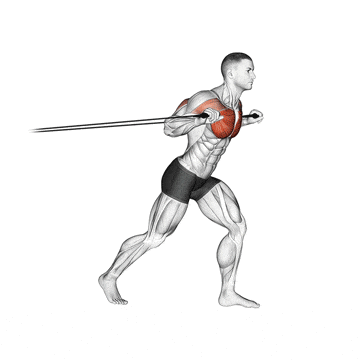
How To Do
- Attach two D-handles to cable pulleys set at about chest height. Stand in the middle.
- Stand in the center of the two pulleys and grip the stirrups.
- Step forward to create tension in the cables, and adopt a staggered stance for stability.
- Engage your core and brace your abs.
- Press the handles forward until they meet in the middle of your chest.
- Pause at the top of the movement for a second, and then slowly return the handles to their original position.
5. Cable Crossover
If you’re looking for straightforward cable machine chest exercises to add to your routine, cable crossover are a great staple exercise to get you started. It provides constant tension, which helps build a massive chest. It helps to develop and define the lower and the Inner pectoral muscles.
Additionally, the cable crossover provides a versatile range of motion, allowing you to adjust the height and angle of the cables to target different areas of the chest. Such as:
- Middle Crossover: Specially target the inner chest
- Low Cable Crossover: Specially target the Upper Chest
- High Cable Crossover: Specially target the Lower Chest
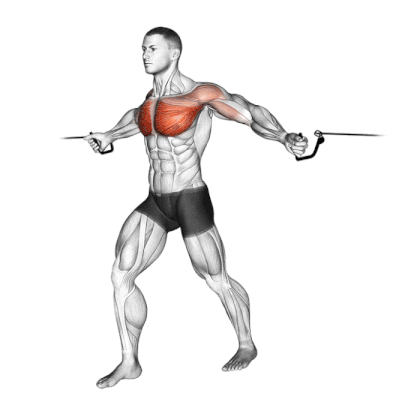
How To Do
- Stand in the center of a cable machine, grasping a handle in each hand.
- Keep your feet shoulder-width apart, and maintain a slight knee bend.
- Position the pulleys at shoulder height or slightly above.
- Cross the cables over each other in front of your body, creating an X shape.
- Slowly bring your hands together and squeeze your chest muscles for one to two seconds.
- Reverse the movement. Use controlled motion and lighter weight for higher reps.
Know More: 14 Best Cable Chest Exercises To Build Bigger Chest
6. Incline Cable Bench Press
During dumbbell incline bench presses, the resistance is directly downward, and your triceps brachii take over much of the force from your chest at the top of the press.
In contrast, the incline cable bench press focuses more on your upper pectoralis major throughout the movement because the resistance originates from an angle. You have to push the stirrups upward and pull them inward at the top of the movement.
Research shows that performing an incline cable fly with a 30 and 45 degree bench angle is the best for the upper chest. Vary the position of the bench to hit different angles of the upper chest.
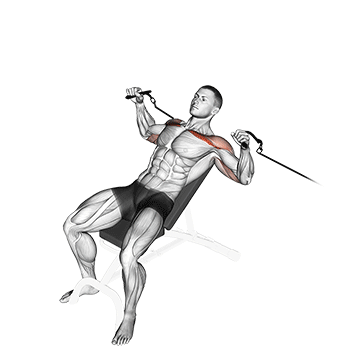
How To Do
- Set the bench at about 30–45 degrees inclined.
- Do not go more upright as the stress shifts to the shoulders rather than the chest area.
- Attach stirrup handles to the low pulleys and lie on the bench with your feet flat on the floor.
- Exhale as you extend your elbows up to move your arms up and inwards until your hands meet.
- Squeeze your chest at the top of the movement and then inhale as you slowly release to the starting position.
7. Cable Pullover
The lying cable pullover is a great alternative to the barbell or dumbbell pullover.
Cable Pullovers are the best exercise for building a strong rib cage and serratus anterior muscle, which together form a complete chest and back. Pullovers work directly on the serratus anterior muscle to develop the back.
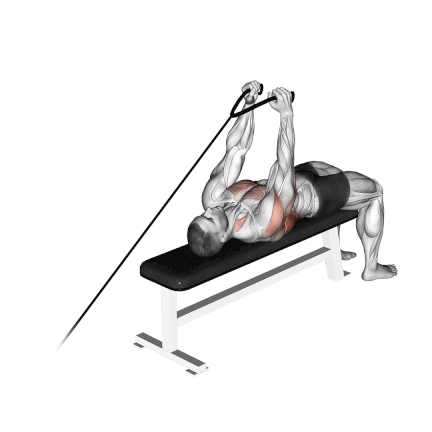
How To Do
- Set up the bench in front of a low pulley cable machine, leaving about 2–3 feet between it and the machine.
- Lay down on the bench on your back with your head up near the end closest to the cable machine. Grasp a rope with both hands.
- Maximum stretching ensures the greatest expansion of the rib cage.
- Keep your arms straight and slowly pull your hands up and across the top of your head.
- Pause, and then lower the weight back to the starting position. Repeat for desired reps.
8. Cable Overhead Press
It is a variation of the shoulder or overhead press, and it’s one of the best exercises for building shoulder size and strength.
Although you might not see many people using the cable machine for shoulder presses, it is still a great exercise to mix in your shoulder workout.
The angle of the cable overhead press can help recruit new muscle fiber that’s not engaged much with other shoulder presses because the force is pulling down behind you.
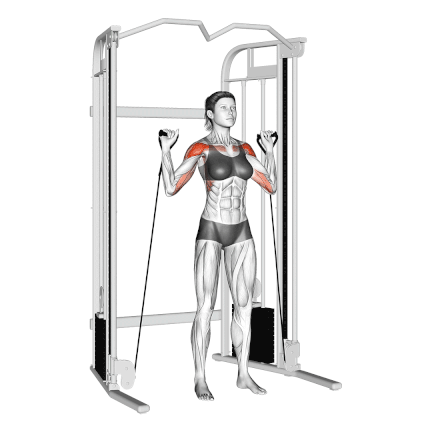
How To Do
- Try to stand as close to the cable machine as possible. Standing too far away can cause the weight to pull you back, placing stress on your lower back and making the exercise more difficult.
- Bend down, grab the cables, and bring them to your shoulders. Feel the stretch in your shoulders.
- Hold for a count at the top, then return to the starting position.
9. Cable Lateral Raise
Cable lateral raises are the most popular shoulder exercise, designed to target the medial deltoid and contribute to a sought-after V-shaped upper body. It provides constant tension on the target muscle group as you move the weight through the range of motion.
Multiple variations of the cable lateral raise exist, but they all have the same common goal: building the lateral delts.
Research indicates that combining lateral and frontal raises can lead to greater shoulder strength gains than just one exercise. This is because lateral raises primarily target the middle deltoid, while frontal raises emphasize the anterior deltoid.
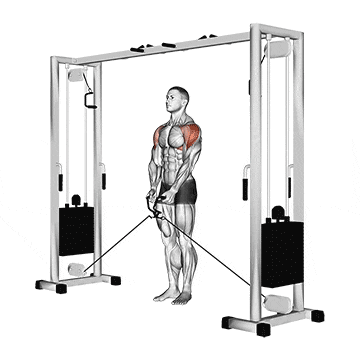
How To Do
- Attach single-grip handles to the lowest point of the cable pulley system.
- The handle from the right pulley should be in your left hand, and the handle from the left pulley should be in your right hand. The cables should be crossed and pulled tightly.
- With elbows slightly bent, raise your arms to shoulder level, leading with the elbow.
- Slowly lower your arms back down until you feel a stretch in your delts and repeat.
- Don’t just swing your arms. Keep motion controlled throughout the exercise.
10. Cable Front Raise
The cable front raise is a cable or machine-assisted shoulder exercise focusing on the anterior deltoid.
It is an isolation exercise that athletes and regular gym goers primarily perform for improved size and strength in the anterior deltoid muscle group.
You can also perform the cable front raise using a rope attachment or a single stirrup, one arm at a time.

How To Do
- Attach a straight bar to a low cable pulley. Grab the bar using a shoulder-width or wider overhand grip.
- Stand close to the pulley with your body upright, your shoulders pulled back.
- Exhale as you pull the bar up the front of your body until the bar is at shoulder height.
- Hold for a count of two. Inhale as you lower the bar to the starting position.
- Repeat for the prescribed number of repetitions.
11. Cable Upright
The cable upright row is a compound exercise primarily targeting your shoulder muscles, specifically the lateral (side) deltoids. It also activates muscles in your upper back, like the trapezius (traps), and involves your biceps for assistance.
The cable upright row is one of the best variations of the upright row that helps to build the shoulders and trap muscles.
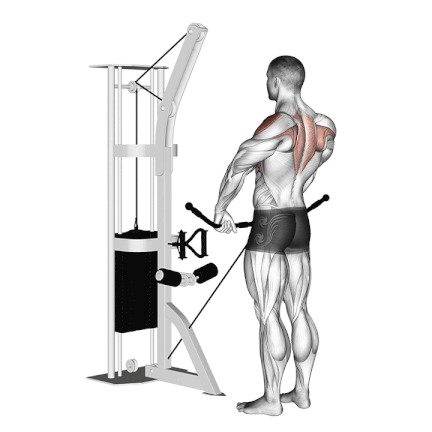
How To Do
- Attach a straight bar to a low cable pulley.
- Position yourself in front of the cable machine with your feet shoulder-width apart.
- Grab the bar using a shoulder-width or wider overhand grip.
- Exhale as you pull the bar up the front of your body until it reaches your middle chest level.
- Do not pull the bar up any higher. Hold for a count of two.
- Inhale as you lower the bar to the starting position.
Know More: Cable Shoulder Exercises For Building Muscle And Strength
12. Face Pull
The face pull is an isolation pulley exercise that primarily works the shoulders and, secondarily, the back.
It specifically targets the posterior deltoids (back of the shoulders), and also works the rhomboids (the muscles that allow you to squeeze your shoulder blades together) and the middle of the trapezius.
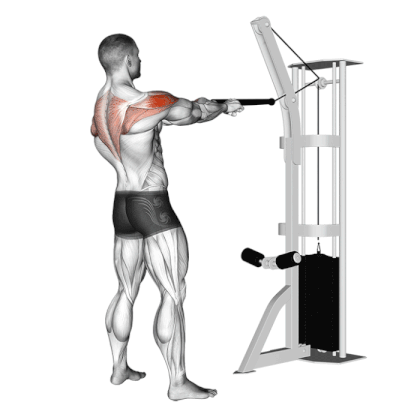
How To Do
- Attach a rope to a pulley placed at approximately chest level.
- Grasp both ends of the rope with an overhand grip.
- Step back so that you are holding the load with your arms fully extended and stand with your feet apart. Bend your knees slightly to provide some stability.
- Retract your shoulder blades and pull the rope toward your face while spreading your elbows out to the sides. Think about spreading the ends of the rope, not just pulling it back.
- Hold the high position for a second and slowly lower yourself.
- Repeat this movement until you have reached the desired number of repetitions.
13. Reverse Cable Crossover
The reverse cable crossover exercise is another great option to help you target the back and grow your back.
Your arms should move directly back (and downward slightly), almost parallel to the floor, to target the rear deltoid, rhomboid, and trap.
Crossing your hands over one another (uncrossing the cables) at the start position increases the range of motion.
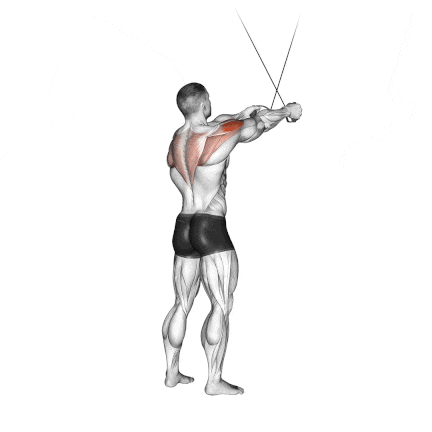
How To Do
- Set the pulleys of a cable machine to the lowest position and attach D-handles to each side.
- Grasp the D-handles with your palms facing forward (pronated grip).
- Start with your arms extended straight in front of you, maintaining a slight bend in your elbows.
- Keep your back straight and shoulders relaxed, and pull the handles apart and back in a wide arc.
- Focus on squeezing your shoulder blades together as you bring your hands towards the sides of your body.
- Slowly return to the starting position in a controlled manner.
- Exhale as you pull the handles apart and inhale as you return to the starting position.
14. Cable Shrug
The cable shrug is a variation of the shoulder shrug and one of the best upper trap cable exercises to build the upper back’s trapezius muscle.
Cable machine shrug, one of the best exercises for isolating the traps, offers versatility to improve development further. The best variations of cable shrugs are:
- One Arm Cable Shrug
- Cable Shrugs Behind The Back
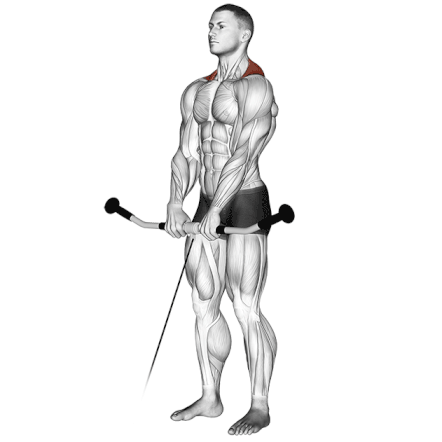
How To Do
- Grab a cable bar attachment that is attached to a low pulley.
- Your hands should be shoulder-width apart or slightly wider if you wish. Your hands should be facing down.
- Stand close to the pulley and extend your arms in front of you while holding the bar.
- Raise your shoulders and lift the bar as high as you possibly can.
- Exhale while performing this movement. Hold the contraction at the top for a second.
- Slowly lower the bar to its starting position.
15. Cable Squat
Cable Squats are an excellent alternative to barbell squats to build quality muscle mass in the legs. These leg exercises are done standing with a cable machine.
One benefit of the cable squat over the barbell squat is that the load is more evenly distributed, and there is a constant load on your legs throughout the whole range of motion.
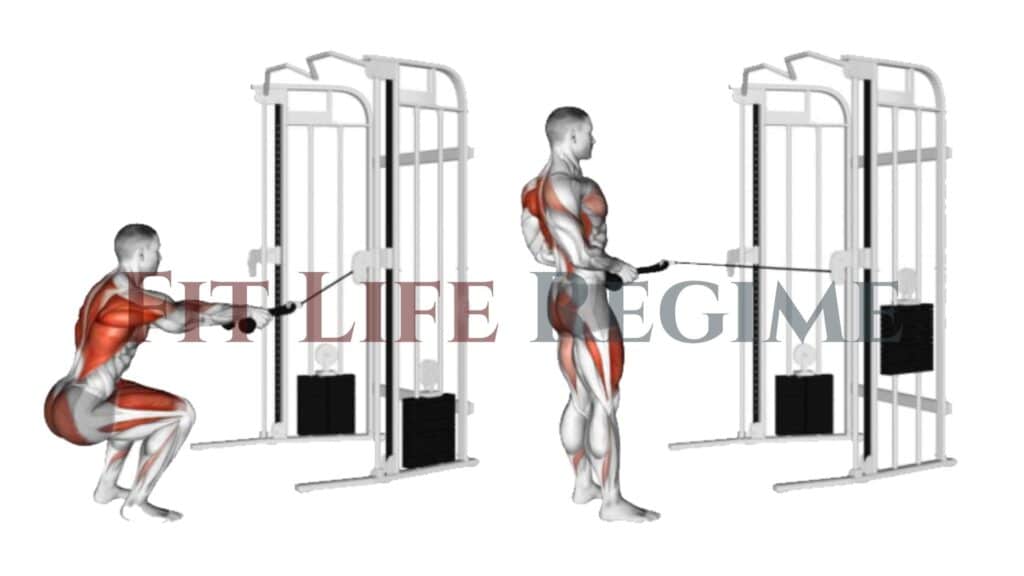
How To Do
- Grip a cable rope in each hand. Stand away from the cable machine so that the slack tightens.
- Make sure your back is straight, and your core is tight.
- Bend your knees and drive your hips back while you keep your chest up.
- Stand back up, then pull the handles back, leading with your elbows.
- Tighten the back muscles, then return the handles to the starting position.
16. Cable Stiff-Leg Deadlift
If you’re looking for a straightforward cable leg workout and exercises to build mass and strength in your legs, then cable stiff leg deadlift, is a great staple exercise to get you started.
The cable stiff-leg deadlift for hamstrings requires a lighter weight than that used during traditional powerlifting for strengthening the lower back.
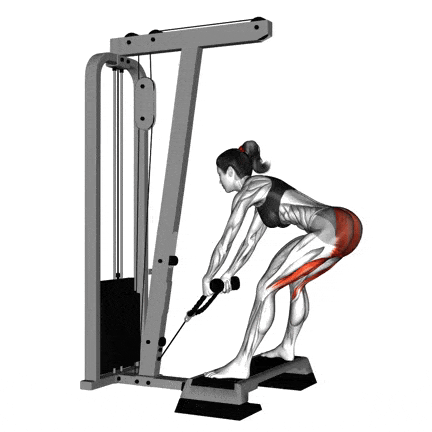
How To Do
- Attach the rope handle to the pulley and position at the lowest position.
- Face the pulley with the rope in both hands and about 3 feet of distance between you and the machine.
- Keeping your back straight, head up, and hips low, lift the cable into a standing position.
- Flex your knees a little and push your hips backward and slowly lower the cable down the front of your legs.
- Descend until you feel a mild stretch in your hamstrings.
- Exhale as you pull the cable back up to the starting position by pushing your hips forward.
Know More: 15 Most Effective Cable Leg Exercises & Workout
17. Cable Pull-Through
The Cable Pull-Through is a popular exercise that targets the glutes and hamstrings for muscle and strength-building purposes.
Now, many people are afraid to perform this movement or are just not interested because it requires a little setup and may even look a little funny.
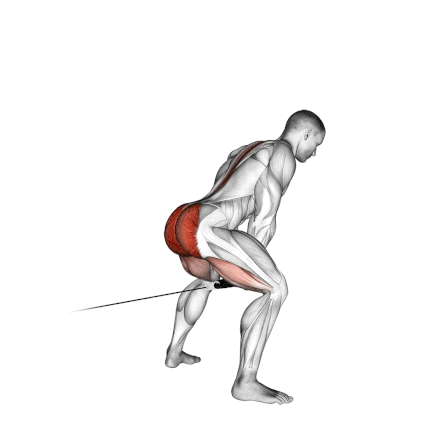
How To Do
- Grasp the attachment of a low cable pulley. Straddle the cable so that your back faces the pulley.
- Step forward until the rope is pulled taut, and stand with your feet shoulder-width apart.
- Keeping your legs and arms straight, exhale as you stand up and pull the cable attachment through your legs.
- Hold for a count of two and squeeze your glutes.
- Inhale as you reverse the motion and return the cable attachment to the starting position with your hips and waist flexed.
18. Tricep Pushdown
The triceps pushdown is the best cable triceps exercise for adding muscle mass to the upper back side of the arms.
Unlike barbell or dumbbell exercises, the cable provides a uniform resistance throughout the movement, where the resistance varies during the lift.
- Using the straight bar, a pronated grip (palms down) emphasizes the outer lateral head of the triceps,
- Whereas a supinated grip (palms up) focuses effort on the inner long head.
- An angled V-shaped bar switches the hands into a neutral grip (thumbs up), equally targeting all three triceps heads.
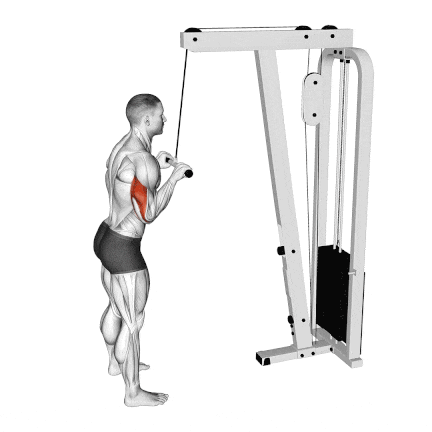
How To Do
- Stand facing a high-pulley cable with a short straight bar attached to it.
- Slightly bend your knees and feet, which should be about shoulder-width apart.
- Grasp the Short bar with a pronated grip (palm down). Hold the bar at chest level with your elbows tight against your sides.
- Keeping your elbows stationary, straighten your arms until they are fully extended.
- Pause at full arm extension, flex your triceps, and slowly return the bar to the starting position.
19. Cable Bicep Curl
If you’re looking for straightforward cable machine bicep exercises to add to your routine, cable curls are a great staple exercise to get you started.
Unlike barbell or dumbbell curls, where the resistance varies during the lift, the cable pulley provides a uniform resistance throughout the movement.
The bicep cable curl is one of the best isolation exercises for the of bicep. It’s a pulling action performed with a cable machine and is suitable for beginners.
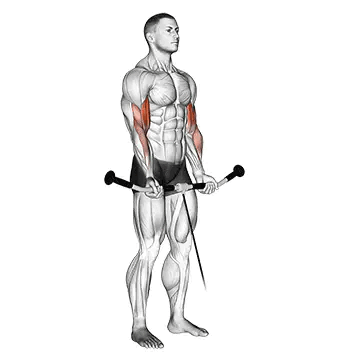
How To Do
- Set up for the cable curl by attaching a straight bar to the low pulley cable.
- Grasp the bar with an underhand grip (palms facing up), and your hands about shoulder-width apart.
- Curl the bar up toward your shoulders by bending at the elbows.
- Lower the weight down to the arms extended position.
Know More: Cable Arm Exercises To Build Bigger Biceps And Triceps
20. Pallof Press
The Pallof Press is a full-body exercise that can increase overall stability and activate many large muscle groups in the body.
It is an anti-rotation hold exercise that will work wonders in helping you develop a stable core.
The Pallof press is a valuable movement prep and core strengthening exercise, and It helps to establish proper spinal alignment under load and increase core stability.
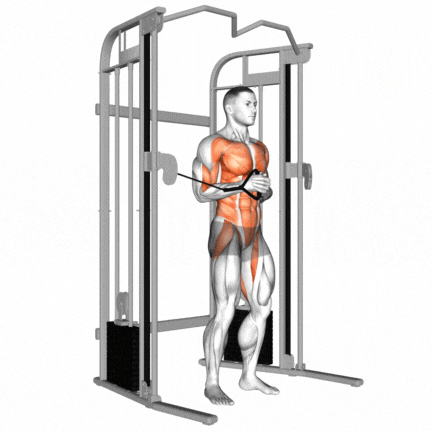
How To Do
- Attach a handle to a chest-high cable pulley.
- Stand on the side cable machine with your feet hip-width apart.
- Grasp the handle with the hand nearest the pulley, pull the handle to your chest, and place your free hand over the hand holding the handle.
- Engage your core and press the handle out with both hands so your arms are extended in front of your chest.
- Hold this position, resisting the pull of the cable and not letting your torso rotate towards the machine, for five to ten seconds, then bring the handle back into your chest.
- Repeat the exercise on your opposite side.
Cables Machine Workout Routines
1. Select Your Goals
- For muscle endurance, do 15-20+ reps with a weight of at least 50 to 70% of your 1RM.
- For muscle strength: 6–10 reps, with a heavier amount of resistance at least 85% of your one-repetition maximum (1RM). The fewer reps you perform, the closer to 100% of your 1RM you should strive for.
- For muscle hypertrophy (increased muscle size): Aim for 3–4 sets of 8–12 reps, with a moderate to heavy resistance of 70 to 85% of your 1RM for 8 to 12 reps.
2. Do Weekly Set
According to the latest scientific evidence, 12–20 weekly sets per muscle group may optimize muscle growth.
- Beginners (with a year or less of training) should aim for about 12 weekly sets.
- An Intermediate trainee (with two to four years of training) can increase the volume to 16 sets per week.
- An advanced trainee (four or more years of training) may be able to get in up to 20 weekly sets.
When a certain amount of volume stops being effective and your progress stalls, you can add sets to increase volume and use that as a driver of renewed progress.
3. Upper Body Cable Only Workout Plan
This regimen generally consists of compound exercises that work multiple muscle groups simultaneously.
| Exercise | Sets | Reps | Rest |
|---|---|---|---|
| Cable Chest Press | 4 | 8-10 | 2-3 minutes |
| Cable Row | 4 | 8-10 | 2-3 minutes |
| Cable Shoulder Press | 3 | 8-10 | 2-3 minutes |
| Cable Bicep Curl | 3 | 10-12 | 1-2 minutes |
| Cable Tricep Pushdown | 3 | 10-12 | 1-2 minutes |
| Cable Face Pulls | 3 | 10-12 | 1-2 minutes |
4. Lower Body Cable Workout Plan
A lower-body cable workout is important for strong, sculpted legs. Exercises like cable squats, leg curls, and lunges effectively target the key muscles of the hips, glutes, quads, and hamstrings.
| Exercise | Sets x Reps | Rest |
|---|---|---|
| Cable Squat | 3×8-10 | 2-3 minutes |
| Cable Deadlift | 3×8-10 | 2-3 minutes |
| Cable Lunges | 3×10-12 each leg | 1-2 minutes |
| Cable Hip Thrust | 3×10-12 | 1-2 minutes |
| Cable Calf Raise | 3×15-20 | 1-2 minutes |
5. 4-Day Full-Body Cable Workout Routine
A 4-day cable workout split enables you to engage your entire body frequently.
Monday
| Exercise | Sets x Reps | Rest (seconds) |
|---|---|---|
| Cable Squat | 3 x 8 | 90 |
| Cable Deadlift | 3 x 10 | 90 |
| Cable Row | 3 x 10 | 90 |
| Cable Bicep Curl | 3 x 12 | 60 |
Tuesday
| Exercise | Sets x Reps | Rest (seconds) |
|---|---|---|
| Cable Chest Press | 3 x 8 | 90 |
| Cable Shoulder Press | 3 x 10 | 90 |
| Cable Lateral Raise | 3 x 10 | 90 |
| Cable Tricep Pushdown | 3 x 12 | 60 |
Wednesday – Rest Day
Thursday
| Exercise | Sets x Reps | Rest (seconds) |
|---|---|---|
| Cable Deadlift | 3 x 6 | 120 |
| Cable Front Squat | 3 x 8 | 90 |
| Cable Seated Row | 3 x 10 | 90 |
| Cable Hammer Curl | 3 x 12 | 60 |
Friday
| Exercise | Sets x Reps | Rest (seconds) |
|---|---|---|
| Cable Incline Chest Press | 3 x 8 | 90 |
| Cable Overhead Tricep Extension | 3 x 10 | 90 |
| Cable High Row | 3 x 10 | 90 |
| Cable Face Pull | 3 x 12 | 60 |
Saturday and Sunday – Rest Days
References
- Signorile JF, Rendos NK, Heredia Vargas HH, Alipio TC, Regis RC, Eltoukhy MM, Nargund RS, Romero MA. Differences in Muscle Activation and Kinematics Between Cable-Based and Selectorized Weight Training. J Strength Cond Res. 2017 Feb;31(2):313-322. doi: 10.1519/JSC.0000000000001493. PMID: 28129277.
- Signorile, Joseph & Rendos, Nicole & Vargas, Hector & Alipio, Taislaine & Regis, Rebeca & Eltoukhy, Moataz & Nargund, Renu & Romero, Matthew. (2016). Differences In Muscle Activation And Kinematics Between Cable-Based And Selectorized Weight Training. Journal of Strength and Conditioning Research. 31. 1. 10.1519/JSC.0000000000001493.

Manish is a NASM-certified fitness and nutrition coach with over 10 years of experience in weight lifting and fat loss fitness coaching. He specializes in gym-based training and has a lot of knowledge about exercise, lifting technique, biomechanics, and more.
Through “Fit Life Regime,” he generously shares the insights he’s gained over a decade in the field. His goal is to equip others with the knowledge to start their own fitness journey.
